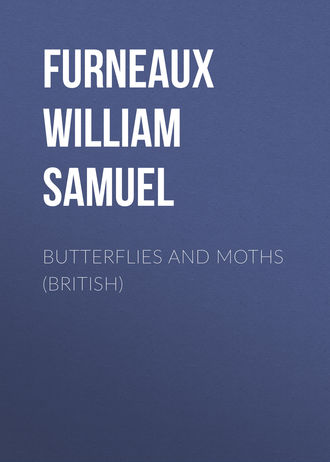 полная версия
полная версияButterflies and Moths (British)
Nearly fifty British Noctuæ are included in the family Hadenidæ. They are of variable dimensions, and differ much in the brightness of their colours, some being very dingy, and others gaily tinted. Their antennæ are rather long; and when at rest the wings slope from the back like the sides of a roof.
The larvæ are smooth, and not very thick; and there is sometimes a hump on the twelfth segment. The pupæ are brown and shiny, and are inclosed in earthen cocoons beneath the surface of the soil.
The Broad-barred White (Hecatera serena)
Fig. 167. – The Broad-barred White.
Although not gaily coloured, this is a pretty little moth, there being a bright contrast between the white ground and the grey markings of the wings. It is common in the south of England, and seems to be plentiful in and around London.
The caterpillar is of a dingy greenish colour, with a yellowish stripe on each side of the back; and there are two distinct dots on the back of each segment. It feeds during July and August on sow-thistles (Sonchus oleraceus and S. arvensis), sleepwort (Lactuca virosa), and hawkweeds (Hieracia).
The moth flies in June and July.
The Marvel-du-jour (Agriopis Aprilina)The Marvel-du-jour is decidedly a beautiful moth – quite an exception among the Noctuæ in this respect, and it is withal both common and widely distributed. We need not describe it, since it is represented on Plate XI (fig. 2), and can hardly be mistaken for any other species.
The caterpillar is dull green, often tinged with red. The dorsal line is broad and dark, and interrupted by a series of very light lozenge-shaped spots. It feeds on the oak in May and June, and is full grown in the latter month. It then burrows into the earth at the foot of the tree, and there constructs a fragile earthen cocoon previous to changing to a chrysalis.
From July to September the chrysalides may be obtained in plenty by breaking up the sods at the roots of oaks, and the perfect insect may be found toward the end of September and throughout October.
The Small Angle Shades (Euplexia lucipara)This pretty little moth is represented in fig. 3 of Plate XI. It is very common throughout the country, and may be seen in June and July.
The caterpillar is thickest on the twelfth segment, and gradually tapers from this towards the head. Its colour is pale green, with a white stripe just below the spiracles, which are black. On each side of the back are a number of oblique lines, which meet in the middle line, thus forming a series of V-shaped marks pointing towards the tail. It feeds on the common bracken fern (Pteris aquilina), foxglove (Digitalis purpurea), and the male fern (Lastræa Filix-mas), in August and September.
The Angle Shades (Phlogophora Meticulosa)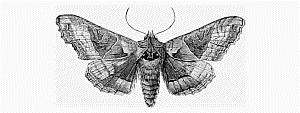
Fig. 168. – The Angle Shades.
This moth is so common and so widely distributed that it is almost sure to be taken by the young collector during his first season. Its wings are scalloped on the hind margin, and their colour light ochreous, often tinged with pink or olive green, and marked with dark brown as shown in the illustration. It is double brooded, the first brood appearing in May and June, and the second in September and October.
The caterpillar is green or olive brown, and thickly covered with white spots. It feeds on groundsel (Senecio vulgaris) and many other low plants, the first brood throughout the winter from November to April, and the second in July and August.
The Grey Arches (Aplecta nebulosa)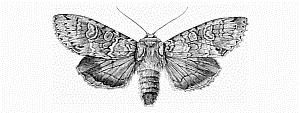
Fig. 169. – The Grey Arches.
The fore wings of this moth vary from greyish white to a rather dark smoky tint. The markings are of a darker colour, and are also subject to considerable variation. The orbicular and reniform spots are large, and paler than the ground colour; and several zigzag or scalloped lines, more or less distinct, cross the wings transversely.
The larva is brown, with a lighter line down the back. On each of the segments five to eleven is a dark lozenge-shaped spot, bisected by the dorsal line; and on the second segment is a shining plate and a triangular mark. It feeds on the dock (Rumex), and various other low plants during the autumn; and, after its hybernation, on the leaves of the sallow (Salix Caprea), birch (Betula alba), and whitethorn (Cratægus oxyacantha). It is full grown in May, when it burrows into the ground to undergo its metamorphoses.
The moth flies during June and July, and is common in nearly every part of Great Britain. Large numbers may be obtained by searching fences and tree trunks about midsummer.
The Shears (Hadena dentina)
Fig. 170. – The Shears.
The Shears is another very common moth of the same family. The ground colour of the fore wings is very variable, but is generally a lighter or darker shade of grey. Sometimes, however, it has a very decided brownish tinge. Across the centre of the wing is a darker band, wider on the costal side, containing the orbicular and reniform spots, as well as a light patch beneath them, and bordered on each side by a pale zigzag line. There is another similar line near to and parallel with the hind margin. The hind wings are smoky grey or smoky brown, darker towards the hind margin.
The caterpillar is greyish, and has a series of triangular black spots along each side of the back. It feeds on the roots of the dandelion (Taraxacum officinale), and changes to a peculiar spiny chrysalis.
The perfect insect appears to be abundant everywhere, and is on the wing in June and July.
The Bright-line Brown-eye (Hadena oleracea)Every collector is sure to meet with this insect during his first season. The moth is abundant everywhere in June, the caterpillar may be found feeding in almost every waste and weedy spot in August and September, and the chrysalis is certain to be turned over by the pupa digger.

Fig. 171. – The Bright-line Brown-eye.
The fore wings of the perfect insect are reddish brown. The orbicular spot is usually very indistinct, being of almost exactly the same tint as the ground colour, and surrounded by a very fine whitish line. The reniform is generally more conspicuous, a portion of it being of a light ochreous colour. Near the hind margin, and parallel with it, is a white line, bent sharply into the form of a W, just on the anal side of the middle.
The hind wings are greyish brown in the base, and dark smoke colour towards the margin.
The caterpillar is pale green or brown, dotted with both black and white, and adorned with a bright yellow line just below the spiracles. It feeds on the nettle (Urtica dioica), dock (Rumex), and many other low plants; and, according to some observers, on the elm (Ulmus campestris).
Family – XylinidæThe next family —Xylinidæ– contains twenty British species, several of which are local, but two or three are abundant and widely distributed.
The transverse lines that so often cross the wings of the Noctuæ are nearly or entirely absent in this family, and longitudinal lines take their place. When the insects are at rest the wings are folded rather closely, the outer pair being arranged like a roof with a very gentle slope. The bodies of the perfect insects are very stout, particularly in the thorax, and thus present a rather powerful appearance.
The larvæ are smooth, and generally brightly coloured, and feed principally on low plants. The chrysalides are generally inclosed in cocoons on or beneath the ground, and are often provided with spines or bristles on the under side.
We shall select two members of this family.
The Early Grey (Xylocampa Areola)One of the first of the Noctuæ to greet us in the spring is the Early Grey, which may be found resting on fences in April, and, if the season is mild, in March.

Fig. 172. – The Early Grey.
Its fore wings are light grey, often tinged with rose pink, and marked with dark grey. The orbicular and reniform spots are very distinct, and surrounded by a pale line; they are both united at their lower edges. Along the hind margin is a series of dark spots. The hind wings are pale yellowish grey, with a darker central spot, a central transverse darker line, and a darker line along the hind margin.
The caterpillar is yellowish grey. The dorsal line is lighter, and passes through a brownish spot on the eighth segment. It feeds on the honeysuckle (Lonicera Periclymenum) in July and August, being full grown towards the end of the latter month.
The Shark (Cucullia umbratica)The Shark is a very common moth, to be found everywhere on palings in June, but the colour of its wings so closely resembles that of oak and other light-wood fences that detection is not so easy as with most other moths.
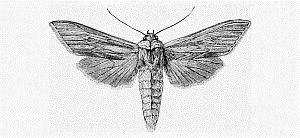
Fig. 173. – The Shark.
The fore wings are grey, and marked with longitudinal dark lines, the principal of which is a line from the middle of the base to about the centre of the wing. The wing rays are also darker than the ground colour. The hind wings are greyish white or brownish grey.
The caterpillar is very dark brown, with orange spots on the back and along the spiracles. It feeds on sow-thistles (Sonchus oleraceus, S. palustris, and S. arvensis) and sleepwort (Lactuca virosa) at night from July to September, and hides during the daytime among the leaves that lie close against the ground. When disturbed it does not roll into a ring or feign death like many others of its kind, but wriggles about most vigorously as if to repel its foe.
Family – GonopteridæThe Herald Moth (Gonoptera Libatrix)The above-mentioned family is so called on account of the angular margins of the wings, especially the fore pair. It contains only one British species, the Herald (Plate XII, fig. 1), a moth that is common everywhere in August and September. It hybernates in the perfect state, and the hybernated specimens may be seen in the spring time, from March up to the end of May or the beginning of June.
Its fore wings are reddish grey, thickly spotted and streaked with brown. Transverse whitish lines divide the base into three parts of nearly equal widths. The basal and central divisions are tinged with orange; and there is a small white spot in the base close to the thorax, also another near the centre of the wing. The hind wings are brownish grey.
The caterpillar is green and velvety, with a whitish stripe on the side, and yellow spiracles. It feeds on willow (Salix alba) and sallow (Salix caprea); and when full grown, about the end of June, it spins a white silken cocoon between leaves of its tree, and changes to a very dark chrysalis.
Family – PlusiidæThe most peculiar feature of the moths of this family is the tufts of hair that stand up perpendicularly on the top of the thorax. The abdomen also is crested, and the fore wings of several species have smooth patches that display a brilliant metallic lustre.
Most of the larvæ may be described as semi-loopers, for their claspers number only three pairs, and when they walk their backs are considerably humped, somewhat after the fashion of the Geometræ. Some of them further imitate the Geometræ in their position of rest, holding on by their claspers only, with body straightened out at an angle with the leaf or twig on which they support themselves.
Unlike the majority of the Noctuæ, they do not descend to the ground when about to change, but spin a silken cocoon among the food plants.
The Burnished Brass (Plusia Chrysitis)
Fig. 174. – The Burnished Brass.
One of the commonest of the Plusiidæ is the Burnished Brass, so called on account of the large patches of bright golden green on the fore wings. The hind margin of these wings is very gracefully curved, and bordered with brown. A brown blotch fills the base of the wing, and the remaining area is of a beautiful metallic greenish yellow, broken by two large brown blotches, one on the costal and the other on the inner margin, which closely approach each other and sometimes meet.
This moth is very common everywhere, and is one of the frequent visitors to our flower gardens from June to August.
The caterpillar is thickest at the twelfth segment, and tapers from this point. Its colour is pale green. It has no longitudinal stripes on the back, but each segment is adorned with four or six oblique white marks. Just above the spiracles is a white stripe. It feeds on the dead nettle (Lamium album), stinging nettle (Urtica dioica), and burdock (Arctium minus), and is full grown in June.
The Silver Y (Plusia Gamma)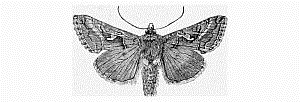
Fig. 175. – The Silver Y.
Our second example of this family is the Silver Y, which may be found in abundance everywhere from June to October. Its fore wings are of a shiny grey colour, beautifully marbled with a rich dark brown; and just below the orbicular spot is a brilliant silvery spot, in form something like the Greek letter γ placed obliquely. The base of the hind wings is grey; along the margin is a broad and dark smoky brown band, and the fringe is very light grey, barred with the dark tint of the band. This moth is commonly driven out of its hiding places among low plants as we walk in waste places, and when thus disturbed it takes a short and rapid flight, generally disappearing so suddenly among the herbage that it is difficult to locate it correctly.
The caterpillar is thickest at the twelfth segment, and tapers gradually from this point towards the head. Its body is green, with several thin longitudinal white stripes, and a thin yellow stripe along the spiracles. It may be found from June to October, feeding on many kinds of low plants.
Family – EuclidiidæThe Mother Shipton (Euclidia Mi)Passing over a few small and less important families, we come to the Euclidiidæ, which contains only two British moths. One of these is the Mother Shipton, a very common insect that flies in June.
The fore wings of this species are very dark brown with whitish markings. The latter include a peculiarly tortuous line, the character of which will be made out more easily from our illustration (Plate XI, fig. 4) than from a written description. The hind wings are also very dark brown, and rather prettily spotted with an ochreous tint.
The caterpillar is pale grey, with four white stripes, and has only three pairs of claspers. It feeds in May on clovers (Trifolium pratense and T. repens) and other plants.
Family – CatocalidæThis family contains only four British species, but these few are very striking moths. They are of large size; and, unlike the Noctuæ generally, the chief adornment is reserved for the under wings. When at rest, the outer or fore wings completely hide the other pair, and then their general appearance is dull, though if closely examined it will be observed that these outer wings are really beautifully marbled with shades of grey.
The caterpillars of this family are very peculiar creatures. Their bodies are convex above and flattened beneath; and if disturbed as they rest on the bark of a tree, instead of leaving their hold and rolling into a ring like so many other larvæ of Noctuæ, they apply themselves the closer, and hold on as if to defy our attempts to remove them. Another peculiarity of these larvæ is the possession of fleshy projections along the sides, just above the legs. They feed on the leaves of trees, and when about to rest they descend to the trunk, and there remain protected by their imitative colouring, detection being rendered even more difficult by the close application of their flattened under surface to the bark. Before changing to the chrysalis state, they spin a light cocoon among the leaves or on the bark.
The Clifden Nonpareil (Catocala Fraxini)This is the largest of the family, and, indeed, of all British Noctuæ. The fore wings and thorax are light grey, dotted and marbled with darker grey (see fig. 5, Plate XI); and the thorax and abdomen are banded with black and greyish blue.
The young entomologist can hardly expect to meet with this fine insect, for it is very rare, and it is only occasionally that a specimen is seen in Britain; but its characteristics are so striking that we have endeavoured to find it a place here. Reputed British specimens of Fraxini command the price of a few pounds each, but specimens from the other side of the Channel may be obtained for a few pence. With such rarities we should advise a young entomologist to purchase the foreign specimen rather than adopt the two other alternatives – give an exorbitant price for a supposed Britisher, or else remain a stranger to the gem, but all foreign specimens should be labelled according to their nationalities.
The Red Underwing (Catocala Nupta)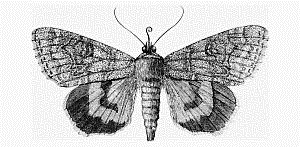
Fig. 176. – The Red Underwing.
The other three members of the family are very similar in appearance, the fore wings of all being marbled with shades of grey, relieved by touches of black and brown; and the hind wings, red or crimson, give the popular names to the species.
The Red Underwing flies in August and September, and is common in the southern counties of England, as well as in some of the midland counties; it may be often seen flying by day around willows.
The caterpillar is similar in form to that of Fraxini, and when at rest by day on the bark of its tree it is very difficult to detect, so closely does it apply itself to the surface, and so perfectly does it imitate the colour of its surroundings. It feeds on the crack willow (Salix fragilis), sallow (S. alba), poplar (Populus), and plum (Prunus), and is full grown in June.
The Dark Crimson Underwing (Catocala Sponsa)This beautiful insect is represented on Plate XI (fig. 6). It will be observed that the black band crossing the centre of the hind wing is rather broad and sharply bent – an important feature, since it is the most serviceable distinguishing mark between this species and the Light Crimson Underwing (C. Promissa).
The caterpillar is similar in form and habits to those of Fraxini and Nupta, and feeds on the oak. It is full fed about the beginning of June, when it changes to a chrysalis between leaves which it has spun together with silk.
The moth flies in July and August, and is common only in certain oak woods of the southern counties. It is particularly abundant in the New Forest, where scores may be taken in a single night by judicious sugaring.
There yet remain a few small families of the Noctuæ, but we must leave them in order that we may give a proportionate share of our space to the other great division of the larger moths – the Geometræ.
CHAPTER XX
GEOMETRÆ
We have already referred (page 28) to caterpillars that walk by a series of strides, alternately looping and extending their long and slender bodies. It is this peculiar characteristic of the larvæ of the present division that suggested the name Geometræ– a term that signifies 'earth-measurers,' for they appear to measure the ground over which they travel in terms of their own length. We have also dealt with the peculiarities of structure in the case of these caterpillars – peculiarities which adapt them to this mode of progression; and we have now to make a selection from the various families of this important division for a more detailed description.
The Geometræ include nearly three hundred species and sixteen families. The moths have slender bodies and full wings, and generally rest with the latter outspread. A few, however, repose with wings erect like the butterflies, and a small number conceal their hind wings after the manner of the Noctuæ.
Family – UropterygidæThe Swallow Tail (Uropteryx sambucaria)Our first family —Uropterygidæ– has only one British representative, and that is the well-known Swallow Tail, so common in gardens and among hedgerows in the south of England. This species is shown on Plate XII (fig. 2), and the insect is so readily identified by the conspicuous 'tails' on the hind wings that no written description will be necessary.
The caterpillar is a most peculiar and interesting creature. Its colour is very variable, being either brown, olive, ochreous, or reddish; and it is notched or humped in such a manner that it exactly resembles a twig. This strange imitation is rendered still more remarkable by the attitude assumed by the caterpillar when at rest. It fixes itself to a twig by means of its two pairs of claspers, with its body standing out at an angle in a perfectly straight posture; but its head is always supported by means of a very slender and almost invisible silk fibre. It feeds on a number of plants and trees, including elder (Sambucus nigra), blackthorn (Prunus spinosa), whitethorn (Cratægus oxyacantha), bramble (Rubus fruticosus), honeysuckle (Lonicera Periclymenum), and forget-me-not (Myosotis arvensis). It may be found feeding in the autumn, or hybernating in the crevices of the bark of trees in winter. In April or May it comes out again; and in June, in which month it is full grown, it binds together some fragments of leaves, and forms them into a little swinging hammock in which it changes to a brown chrysalis spotted with black.
Just at this time it seems to be particularly sensitive. In the caterpillar state it will strongly resent any kind of disturbance, and will give a blow to an intruder by suddenly swaying its body right and left; and while in its hammock a gentle irritation, such as a puff of wind from the mouth, will set it wriggling in a furious manner.
Family – EnnomidæThis family contains about twenty species, several of which rank among the commonest as well as the most beautiful of the Geometræ. Their wings are more or less angulated; and the antennæ are generally pectinated in the males.
The larvæ are generally humped and twig-like; and, as in the last species, the semblance is increased by the position they assume when at rest. The number of limbs varies from ten to fourteen, but where the claspers exceed two pairs, the additional two or four, as the case may be, are seldom used in walking.
The Brimstone Moth (Rumia luteolata)As soon as the warm evenings of May set in, this lively and bright little moth may be seen flitting about among our hedges at sunset; and it continues with us throughout the whole of the summer, but is particularly plentiful during the month of June.
The moth itself need not be described, since it is shown on Plate XII (fig. 3); but the caterpillar (fig. 25) must receive a passing notice. It varies considerably in colour, being either green, brown, or marbled with a mixture of shades of both these colours. It has a hump on the back of the seventh segment, and two more on the ninth, and possesses four pairs of claspers. It feeds on whitethorn (Cratægus oxyacantha), blackthorn (Prunus spinosa), and the apple (Pyrus Malus), and may be found on these trees throughout the summer.
Some believe that there are three successive broods of this insect each year, but it is doubtful whether this is invariably the rule, since both the moth and its larva are to be found without intermission throughout the season.

